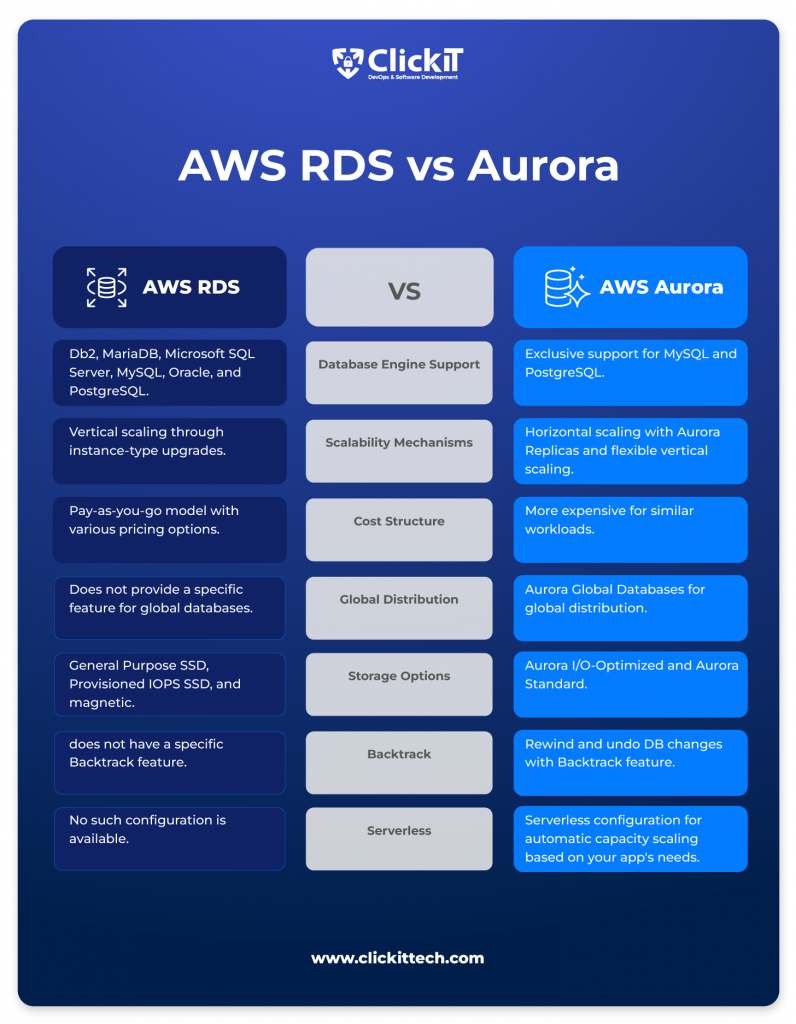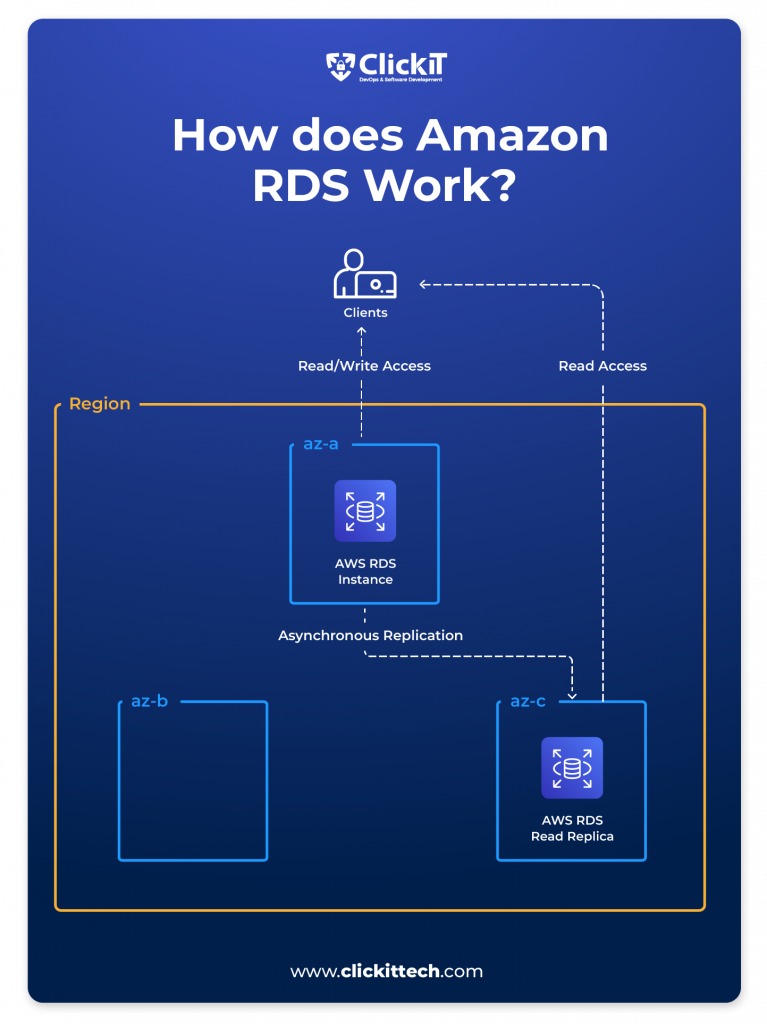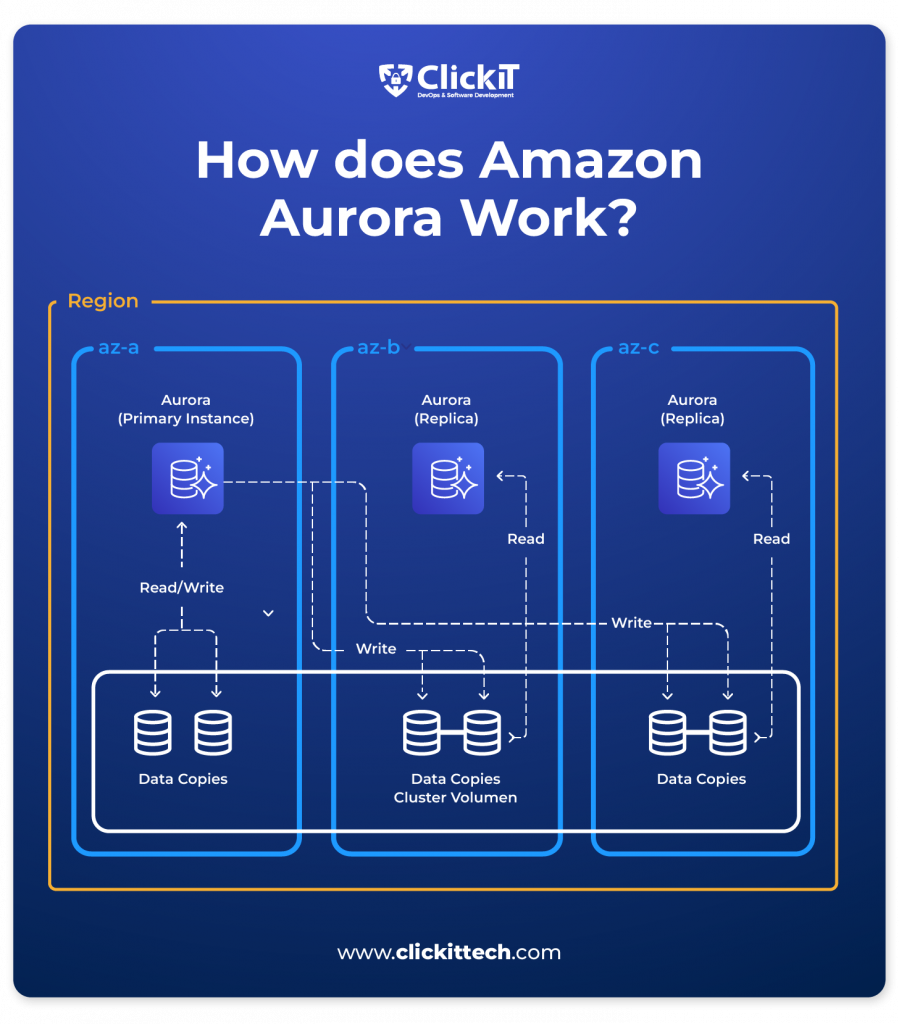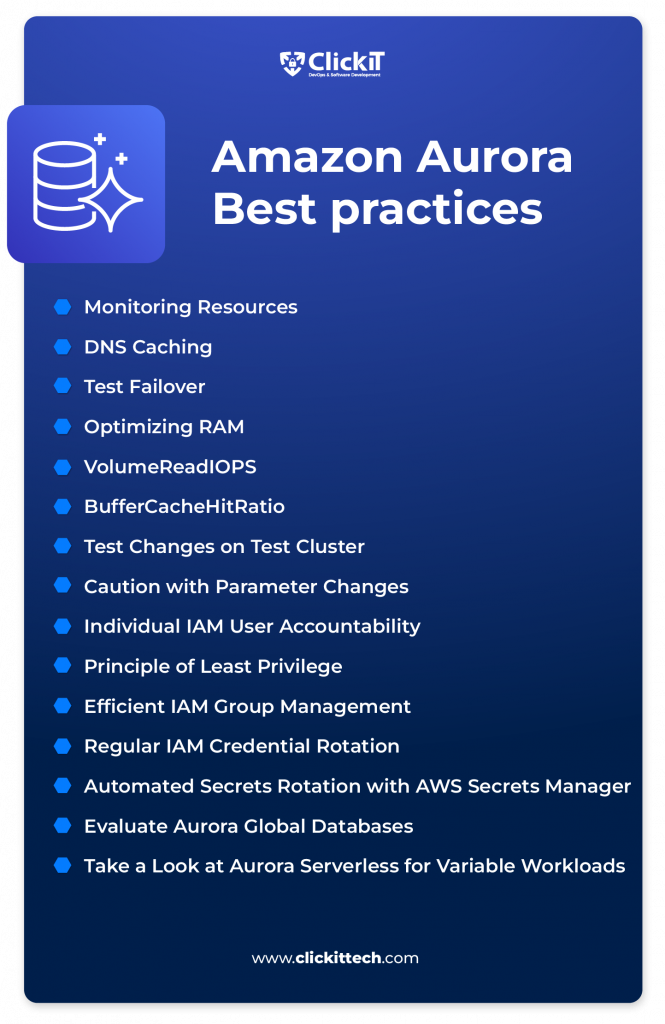Deciding between AWS RDS vs Aurora can be a game-changer for your applications, the right database be the secret sauce to supercharge your cloud applications? Well, AWS has you covered with Amazon RDS and Aurora.
AWS RDS offers a fully managed solution for relational databases in the AWS Cloud. It guarantees smooth operation and gives you more time to concentrate on your applications by supporting several database engines, including Db2, MariaDB, Microsoft SQL Server, MySQL, Oracle, and PostgreSQL.
On the other hand, Amazon Aurora, built for the cloud, is a Relational Database Management System (RDBMS) that fully supports PostgreSQL and MySQL on AWS RDS. For a tenth of the price, Aurora offers the availability and performance of commercial-grade databases.
This blog breaks down Amazon Aurora vs RDS, aiding you in making a smart choice for your cloud applications. So, let’s jump into the specifics and see how Amazon Aurora vs RDS might benefit your cloud journey!
Table of contents
- Database Management: AWS RDS Aurora
- AWS RDS vs Aurora Comparison
- What is AWS RDS?
- AWS RDS Best Practices
- AWS RDS vs Aurora: What is Amazon Aurora?
- Amazon Aurora Best Practices
- Comparison of AWS RDS vs Aurora
- Amazon Aurora vs RDS Use Cases
- Conclusion of AWS RDS vs Aurora
- AWS RDS vs Aurora FAQs
Database Management: AWS RDS vs Aurora
Managing relational databases in the cloud back in the early days of database administration was not easy. From hardware configuration to regular maintenance such as updates and backups, manual labour was required. Organizations frequently suffered from this complexity, which distracted them from creating applications.
It required careful planning and ongoing monitoring to ensure maximum availability and security. Database management expertise was necessary for scaling activities, which required cautious execution. It was a labor-intensive process that required a committed crew.
This contextual history highlights an era in which organizations faced difficulties due to human labour and resource-intensive database administration procedures. It prepared the way for a revolutionary change that led to the emergence of more automated and effective solutions in the following years.
AWS RDS vs Aurora Comparison
Although Amazon Aurora vs RDS have similar features and advantages, there are some important differences that should be considered before making a choice. Knowing these distinctions will enable you to select the solution that best suits your individual requirements.

AWS RDS vs Aurora: What is AWS RDS?
AWS RDS, or Amazon Relational Database Service, is a significant development in the field of cloud database systems. Is a fully managed service designed to simplify and streamline the process of setting up, operating, and scaling relational databases in AWS Cloud. RDS allows users to select the database engine that best suits their unique application requirements by supporting various database engines. Popular platforms, including Db2, MariaDB, Microsoft SQL Server, MySQL, Oracle, and PostgreSQL are among the supported engines.
AWS RDS stands out due to its commitment to offering a fully managed experience. It also means that the service takes care of standard database operations like patch management, hardware provisioning, and backups. AWS RDS frees users from the burden of database administration by automating these processes, freeing them up to concentrate their time and resources on developing applications.
Another affordable pay-as-you-go pricing model used by AWS RDS enables users to scale their resources according to real usage. This adaptability helps ensure the best possible resource and cost allocation.
How does Amazon RDS Work?
Now, in AWS RDS vs Aurora debate, let’s see how RDS works.

By enabling customers to create instances using the AWS maintenance Console, CLI, or API, Amazon RDS streamlines database administration. It allocates computing resources according to selected instance types, abstracting away the complexity of the infrastructure. Amazon EBS volumes are used to store data, and users have the option of using Multi-AZ deployment for data redundancy.
When you enable Multi-AZ, it keeps a redundant and consistent standby copy of your data. AWS RDS automatically changes to the backup copy in case the original copy experiences issues, ensuring that the data remains available. Two distinct Availability Zones maintain the two copies.
To achieve the Multi-AZ capability, a replication layer deployed between the database application and the Amazon Elastic Block Store (Amazon EBS) volumes is used. This layer maintains two distinct EBS volume copies, one accessible locally and the other remotely. It manages application read and write requests and applies them in this context.
Raed our blog, Amazon RDS instance
AWS RDS Benefits
In the Amazon Aurora vs RDS debate, let’s review the benefits of each; starting with RDS, a flexible and adaptable solution that makes managing relational databases in the AWS Cloud easier is Amazon Relational Database Service (AWS RDS). Let’s explore AWS RDS’s benefits to see how it changes the database management scene. AWS RDS offers a wide range of benefits, including cost-effectiveness, robust data protection, high availability, customizable performance, and scheduled backups.
Easy to Manage
Beyond user interface design, AWS RDS makes managing databases quite simple. The platform provides a controlled experience that automates repetitive operations while abstracting the complexity of database maintenance. In addition to making navigation simple for administrators, this lowers the learning curve for database management, which empowers development teams.
Automated Backups
When it comes to data safety, AWS RDS’s automated backup capability is revolutionary. Without requiring human involvement, AWS RDS makes sure you have a reliable backup plan by regularly capturing snapshots of your database. This automated method reduces the chance of data loss in unanticipated events while also saving time.
Customizable Performance
In the world of databases, there is no one size fits all solution, and AWS RDS is aware of this. Organizations can fine-tune their database environment to meet the unique requirements of their applications by customizing the performance parameters. Because of its adaptability, performance is guaranteed to meet the changing demands of dynamic workloads.
High Availability with Multi-AZ Deployments
AWS RDS’s resilience in maintaining high availability and robustness is evidence of its reliability-focused design. In order to reduce downtime in the event of failures, the platform’s Multi-AZ setups replicate databases across multiple Availability Zones. A comprehensive approach to data preservation includes user-initiated backups and access point-in-time recovery.
Data Security
In the current digital world, security cannot be compromised, and AWS RDS takes a multifaceted approach to addressing this issue. Sensitive data is protected by encryption both in transit and at rest, and network isolation is guaranteed by hosting database instances in Amazon VPC. A secure database environment is produced by resource-level authorization, industry standards compliance, and threat detection via Amazon GuardDuty.
Cost-effectiveness
The price structure of AWS RDS is centered on cost-effectiveness. The pay-as-you-go model encourages financial efficiency by ensuring that businesses only pay for the resources they use. Optimizing resource usage is possible by using Reserved Instances, which also unlock substantial discounts. Resource usage can also be optimized with the flexibility to start and stop database instances.
Database Engine Flexibility
AWS RDS offers flexibility for a range of use cases by supporting several database engines. RDS provides a multitude of alternatives, regardless of whether you require Db2, MariaDB, Microsoft SQL Server, MySQL, Oracle, or PostgreSQL.
AWS RDS Best Practices
Beyond just creating Amazon RDS instances on AWS, effective use of the service entails implementing best practices to optimize its performance, security, and dependability. It’s critical to comprehend and put these best practices into effect as more and more businesses rely on cloud-based databases to run their apps. A planned approach to configuration, optimization, and maintenance may greatly improve the effectiveness and robustness of your database infrastructure, regardless of the type of database you are managing.
To ensure that your Amazon RDS environment is reliable and ready for growth and flexibility, we recommend crucial best practices in this context that address a range of factors, from deployment strategies and backup procedures to security measures and performance tuning.

Monitoring Resources
To keep an eye on important metrics like RAM, CPU, replica lag, and storage utilisation, use Amazon CloudWatch. Configure alerts to be notified when deployment capacity is approaching or when usage patterns shift.
DNS Caching
In client applications, set a low time-to-live (TTL) value (less than 30 seconds) for DNS caching. Reducing the amount of time that DNS is cached can help you prevent connection problems thereafter.
Failover Testing
Test your database instance’s failover scenarios on a regular basis. Check to see if, following failover, applications connect to the new DB instance automatically.
DB Instance RAM Allocation
Allocating enough RAM will ensure that the working set is primarily stored in memory. Monitor the ReadIOPS measure in CloudWatch; if scaling up results in a significant drop in ReadIOPS, keep increasing until peak performance is reached.
Individual IAM User Accountability
Create an individual IAM user for every person in charge of managing Amazon RDS resources, including administrators. Do not rely on your AWS root credentials for typical RDS administrative operations.
Principle of Least Privilege
Following the least privilege principle, provide each IAM user the minimal set of rights required to carry out their particular duties.
Efficient IAM Group Management
Take advantage of IAM groups to handle permissions for multiple users efficiently , and to maintain an orderly framework for access control.
Regular IAM Credential Rotation
Change your IAM credentials regularly to improve security. Updating secret keys and access keys regularly reduces the risk of having compromised or out-of-date credentials.
Automated Secrets Rotation with AWS Secrets Manager
Set up AWS Secrets Manager to rotate secrets related to Amazon RDS automatically. Automated rotation lowers the possibility of unauthorized access by ensuring that database credentials are regularly renewed.
Multi-AZ Deployment for High Availability
To improve availability, use multi-AZ deployments to automatically duplicate your database to a standby instance in a different Availability Zone.
Enable Automatic Backups
Activate automated daily backups with a suitable retention period so that, in the event of data loss, rapid and reliable point-in-time recovery is possible.
Keep your Database Engine Versions Updated
Update your database engine frequently to the most recent version to take advantage of security patches and new features for best performance.
AWS RDS vs Aurora: What is Amazon Aurora?
A significant advancement in cloud database systems is represented by Amazon Aurora, a well-known member of the Amazon Web Services (AWS) database family. Amazon Aurora is a fully managed Relational Database Management System (RDBMS) for cloud-based applications designed to provide a scalable, high-performance, and affordable solution.
Because it was developed using cloud-native concepts, Amazon Aurora combines the greatest features of MySQL and PostgreSQL. It offers all the performance and availability of high-end commercial databases with the user-friendly interface of open-source databases.
Amazon Aurora empowers users by providing a completely managed experience for typical database activities, such as patch management, hardware provisioning, and backups, which are handled automatically by the service itself. This is similar to its counterpart, AWS RDS.
Read our blog Amazon Aurora Database Service
How does Amazon Aurora Work?
Now, in the AWS RDS vs Aurora debate, let’s see how RDS works.

AWS Management Console, the Command Line Interface (CLI), or the API can all be used by customers of Amazon Aurora to set up database clusters. Read replicas and a primary instance are part of this cluster architecture.
The primary instance manages all data modifications to the cluster volume and allows read and write activities. The replica instance, which is connected to the same storage volume as the primary DB instance, supports only read operations. Aurora stores data in the cluster volume, which consists of copies of the data across three Availability Zones in a single AWS Region. These cluster volumes are made of solid-state drives(SSDs).
Amazon Aurora Benefits
In the discussion of Amazon Aurora vs RDS, let’s explore the adaptability of Amazon Aurora, a user-friendly solution that is changing relational databases that are hosted in the cloud. We’ll explore the primary benefits that make database administration easier.
Aurora has many benefits, including improved security measures, superior performance, and streamlined processes. Let’s explore how these features support a smooth and effective database experience.
Fully Managed
Use AWS Aurora to benefit from a fully managed database service. Hardware provisioning, patch management, and backups are only a few of the regular administrative duties handled by the platform. With this managed solution, your team won’t have to worry about losing their heads in the complexities of database maintenance and can instead concentrate on creating innovative applications.
High Performance and Scalability
AWS Aurora excels at providing demanding workloads with high performance. Its specially designed storage subsystem guarantees low-latency data access, and features like parallel query processing increase the database’s overall efficiency. Because of Aurora’s seamless scalability architecture, your database can easily grow or shrink to meet fluctuating demands.
High Availability and Durability
High availability and durability are top priorities for Aurora, guaranteeing that your database will continue to function even in the event of a breakdown. The platform offers strong tools to minimize downtime and ensure continuous database operations, such as automated failover and Aurora Replicas. Using Aurora, users may now turn back time and access their database to a certain point in time using the unique Backtrack feature.
Highly Secure
AWS Aurora places a high focus on security. The platform protects your sensitive data throughout its lifecycle by providing encryption both in transit and at rest. Network isolation is provided by running Aurora instances inside an Amazon VPC, and resource-level permissions provide you with fine-grained control over what AWS users and groups can do.
Cost-Effectiveness
Thanks to Aurora’s cost-effective business approach, you may pay for the resources you use. The platform’s resource efficiency and scalability in response to demand facilitate optimal cost management. Pay-as-you-go pricing allows users to pay only for the computing and storage resources they actually utilize.
Aurora Global Databases
Using Aurora, you may build global databases that are spread over several AWS regions. This functionality offers low-latency access to the database from various locations across the globe and is intended for internationally distributed applications.
Amazon Aurora Best Practices
In the constantly changing world of cloud computing, optimizing your database’s performance, availability, and security is crucial. Amazon Aurora, provides a robust option for those looking for scalable, high-performance databases that work with MySQL and PostgreSQL.
Adopting best practices that complement Amazon Aurora’s distinct design and capabilities is essential to realizing its full potential. Strategic configuration, monitoring, and maintenance methods become essential when managing a heavy application burden or striving for increased resilience. We’ll go over important best practices for Amazon Aurora, including deployment tactics, backup procedures, security precautions, and performance enhancements.

Monitoring Resources
Use Amazon CloudWatch to periodically check memory, CPU, and storage utilization. To ensure system uptime and performance, set up alerts for changes in usage patterns or nearing capacity limitations.
DNS Caching
A TTL value of less than 30 seconds should be set if your client application caches DNS data. This lessens the likelihood of connection failures brought on by underlying IP address changes, which might happen during failovers or maintenance procedures.
Test Failover
Test your Aurora DB cluster’s failover on a regular basis to gauge how long it will take. In order to guarantee smooth application access to the new DB cluster after failover, failover testing is essential.
Optimizing RAM
Make sure the working set is almost totally in memory by allocating enough RAM. Track metrics in Amazon CloudWatch such as VolumeReadIOPS and BufferCacheHitRatio to assess how well your database cluster is operating and how much memory it is using.
VolumeReadIOPS
Keep an eye on VolumeReadIOPS to spot irregularities or spikes in read I/O operations. Examine the instances generating more I/O, and if necessary, consider increasing the DB instance class.
BufferCacheHitRatio
Watch the BufferCacheHitRatio to determine the proportion of requests fulfilled by the buffer cache. While a low hit ratio implies that queries are being written to disc frequently, a high ratio shows enough memory available. Examine the DB instance class and, if necessary, increase its size.
Test Changes on Test Cluster
Test DB parameter group and DB cluster parameter group changes on a test DB cluster prior to implementing changes in production. Poorly set parameters might result in unstable systems and decreased performance.
Caution with Parameter Changes
While changing the DB engine’s parameters, proceed with caution. Prior to making any changes to DB parameter groups, always make a backup of your database cluster.
Individual IAM User Accountability
For every person in charge of managing Amazon RDS resources, including administrators, create an individual IAM user. For typical RDS administrative operations, do not rely on your AWS root credentials.
Principle of Least Privilege
Following the least privilege principle, provide each IAM user the minimal set of rights required to carry out their particular duties.
Efficient IAM Group Management
Take advantage of IAM groups to handle permissions for multiple users efficiently, and to maintain an orderly framework for access control.
Regular IAM Credential Rotation
Change your IAM credentials on a regular basis to improve security. Updating secret keys and access keys on a regular basis reduces the risk of having compromised or out-of-date credentials.
Automated Secrets Rotation with AWS Secrets Manager
Set up AWS Secrets Manager to rotate secrets related to Amazon RDS automatically. By ensuring that database credentials are regularly renewed, automated rotation lowers the possibility of unauthorized access.
Evaluate Aurora Global Databases
For low latency access and disaster recovery, replicate your database across several AWS regions with Aurora Global Databases.
Take a Look at Aurora Serverless for Variable Workloads
Reduce expenses by using Aurora Serverless, which modifies database capacity for applications with fluctuating workloads depending on actual consumption.
AWS RDS vs Aurora Use Cases
AWS RDS
Building Web and Mobile Applications
Amazon RDS is a core component supporting the complex process of managing product catalogues, customer data, and transactional information. It is necessary for every e-commerce platform that aims to offer a smooth and effective shopping experience to a diversified client base.
Amazon RDS’s scalability features are crucial in the ever-changing world of online retail, where demand patterns can see significant fluctuations.
The e-commerce site sees a spike in user traffic during shopping seasons of high demand, such as holiday sales or promotional events. Customers can shop with peace knowing that the database architecture can accommodate higher transaction volumes thanks to Amazon RDS’s ability to automatically expand resources. This feature also helps to prevent performance bottlenecks.
Additionally, an e-commerce platform’s ability to continue operating depends heavily on Amazon RDS’s reliability and availability. The platform can achieve greater resilience with capabilities like Multi-Availability Zone (Multi-AZ) deployments by replicating databases over several different geographic zones.
In addition to guaranteeing data durability, this also offers a failover method, lowering the possibility of downtime and guaranteeing ongoing service availability for clients and retailers. The e-commerce platform can now concentrate on providing an engaging online shopping experience without having to worry about laborious database management activities thanks to Amazon RDS.
Moving to managed databases
Making the switch to managed databases presents an opportunity for creativity. The difficulties of time-consuming, difficult, and expensive database administration are removed when using Amazon RDS, as developing new apps becomes a smooth process free from the weight of self-managing databases. For a more effective and economical approach, RDS handles the operational details, freeing you up to concentrate on application development and innovation.
AWS Aurora
Modernizing Enterprise Applications with AWS Aurora
An organization seeking to update its customer relationship management (CRM) system and enhance overall business processes looks to AWS Aurora in the context of modernizing enterprise applications. Mission-critical enterprise applications require high availability, durability, and performance, and Aurora is a robust relational database engine that can work with both MySQL and PostgreSQL.
AWS Aurora makes sure that client data for the CRM system is easily accessible and safely maintained for a range of business needs. Aurora protects against probable outages or failures by replicating data across many Availability Zones, which increases the application’s availability. This is especially important to guarantee smooth interactions and transactions by providing constant access to customer information.
Additionally, the company may take advantage of well-known database technologies thanks to AWS Aurora’s compatibility with MySQL and PostgreSQL, which helps development teams quickly adjust and reduces their learning curve. Instead of worrying about operational nuances, the organization can concentrate on optimizing the functionality of its CRM application because the platform can automatically manage regular database activities like backups and software patching. Enabling enterprise applications with the scale and dependability required for a strong CRM system makes AWS Aurora a smart choice.
Deploying globally distributed applications
Amazon Aurora provides critical multi-region scalability in the domain of internet-scale applications, where user demands might spike at any time. It is the foundation for creating globally distributed, internet-scale applications that meet a variety of requirements, including social media apps, online services, and mobile gaming.
This guarantees the best possible performance and responsiveness in a variety of geographical locations, accommodating varying workloads with ease.
Data replication across many Regions, which guarantees data persistence and a failover mechanism, highlights the architecture’s resiliency. Thanks to Amazon Aurora, businesses can deploy globally distributed apps with confidence, giving users a dependable and high-performance experience everywhere.
Conclusion of AWS RDS vs Aurora
Amazon Relational Database Service (RDS) and Amazon Aurora are two powerful options offered by Amazon Web Services (AWS) in the quickly changing field of cloud-based database administration.
For developing online and mobile applications, Amazon RDS provides a simplified ride. It’s a dependable companion with scalable support for expanding apps, outstanding availability, and a flexible pay-per-use approach. Considering making the move to managed databases? RDS takes over, freeing you from the burden of managing complex database administration so you can concentrate on innovation. And Amazon RDS is the game-changer for companies looking to break free from old databases, offering excellent scalability, performance, and availability at a fraction of the price.
Conversely, in Amazon Aurora vs RDS, Amazon Aurora is the modern choice for revamping enterprise applications. Aurora offers superior performance and high availability for any kind of application, be it SaaS, ERP, or CRM. Internet-scale apps that are scaling globally? Aurora is your worldwide buddy, guaranteeing robustness throughout various areas. Furthermore, Aurora offers fine-grained scaling, making it an affordable serverless solution.
In conclusion, a variety of criteria, including cost, performance, scalability, availability, and use case, affect the decision between AWS RDS vs Aurora. Both services offer strong solutions, therefore the choice you make between Amazon Aurora vs RDS should be in line with the particular requirements and objectives of your company. This blog provides the information you need to make wise decisions as you start your cloud database journey and ensure your apps flourish in the ever-changing cloud environment.

AWS RDS vs Aurora FAQs
While Amazon RDS supports 6 Database Enginees viz Db2, MariaDB, Microsoft SQL Server, MySQL, Oracle, and PostgreSQL, Amazon Aurora is compatible with only PostgreSQL and MySQL.
Yes, it is possible to migrate data between Amazon RDS and Amazon Aurora. You can migrate easily if you’re currently using a database engine- such as MySQL or PostgreSQL- that is supported by both services.
The fundamental functionalities of AWS RDS are carried over to AWS Aurora, along with additional functionality designed for MySQL and PostgreSQL. This similarity supports AWS’s objective of offering a seamless cloud experience, guarantees a consistent user interface, and makes moving between services easier. Consider Aurora a more advanced version with database-specific optimizations.
Aurora extends the basis of RDS while introducing new features like improved read scalability, faster replication, and a high-performance storage subsystem. Aurora becomes even more special with these improvements, providing better features for PostgreSQL and MySQL databases. Thanks to the shared basis, users who are used to RDS can transition with ease.
No, Amazon RDS only supports certain database engines; custom or third-party engines are not currently supported.









